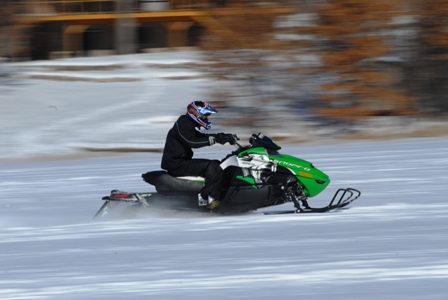I jumped at the chance to ride a Speedwerx-modified Arctic Cat Z1 Turbo this week, a sled that is mind-boggling because, with a twist of a switch, you can jump from the stock 175 hp to 210 hp, 260 hp or a whopping 290 hp!
Speedwerx is coaxing these incredible numbers from the Z1 Turbo by means of increasing boost. To accomplish that, they’ve gone through the delicate (and painstaking) process of reverse-engineering the engine’s ECU in order to reprogram the stock parameters for fuel control, turbo boost pressure and rev limit.
This is a seriously important feature to Speedwerx’s modification. They are reprogramming the entire ECU map, which is different than the other plug-and-play fuel controls that only affect a few parameters. It’s taken them a lot of time and resource to reverse-engineer the ECU, but they believe the comprehensive map changes deliver improved performance, rideability and engine longevity.
Speedwerx offers Z1 Turbo owners several options for boost increase. The most comprehensive is their adjustable map kit, which costs $600 and offers the ability to choose (via a subtle, dash-mounted dial switch shown above) four levels of performance:
Level 1: delivers 177 hp (just a couple more than stock) while using the Speedwerx muffler AND 87 octane fuel. Keep in mind that Cat requires owners to use 91 octane…so this setting/package lets you keep your stock hp even if you have to use low-octane fuel.
Level 2: delivers 210 hp while running 91 octane fuel.
Level 3: delivers 260 hp that requires either 114 octane fuel, or Speedwerx’s methanol injection (more on this in a moment). This setting jumps to 290 hp when used in conjunction with the Speedwerx Waste Gate shim.
Level 4: the stock Arctic Cat calibration, which means 175 hp using 91 octane fuel.
(Note: the above numbers include using a Speedwerx lightweight muffler)
Riders who don’t want the full four-position adjustability of this system can opt for a $400 single fuel map that corresponds with any one of these levels.
If you’re using Level 3, either as a single map or using their adjustable map kit, riders must use either 114 octane fuel, or the Speedwerx Methanol kit.
The Speedwerx meth kit consists of a pump, reservoir, nozzle, and necessary hardware/lines.
You can see the meth kit pump below the battery, along with a second-gen prototype of the lightweight muffler. Mounting is straightforward and clean, with little outward appearance of the beast it brings to life.
The meth kit (price is TBD) contains a reservoir that mounts behind the nose cone, almost imperceptible except for a small filler cap. Plastic lines run through a pump that mounts just below the battery, and to an injector mounted on the intake header. The system ties into the sleds ECU to automatically inject methanol during accelerations, which cools the intake and cylinder head to eliminate detonation. The half-gallon reservoir holds enough methanol for 12-14 full-throttle blasts before it needs a refill. A small light mounted on the dash indicates when the bottle is empty.
And refilling is cheap and easy, since methanol comprises everyday windshield washing fluid. Yep, just refill with everyday washer fluid (although Speedwerx recommends using the blue-colored stuff). Justin Tate gives it a topping-off before heading out on a test ride.
Adding the single or adjustable boost kit also requires a $175 Speedwerx clutch kit, a no-brainer considering the increased hp.
I tested the full 290-hp, adjustable-map package using the Meth kit. I joined Speedwerx employee (and top-level snocross racer) Justin Tate, and we rode from Speedwerx’s Forest Lake, Minn., shop to a nearby, secluded lake. Short bursts along the ditchline ride to the lake told me that this was no ordinary snowmobile, and that 290 hp needs to be respected.
On the lake, my eyes opened WIDE to the sheer freakishness of 290 hp. The sled was clutched to engage at 2,500 rpm. The boost is calibrated to kick in at roughly 5000 rpm, and when it did, it pulled Holy-$#!#-HARD right up to 115 mph, at which point I had to let off in order not to go flying into the cattails.
Amazing, really.
Despite a track full of ice picks, the 2-3 inches of fresh snow on the lake prevented the track from hooking up the entire distance of each blast. It’s a bit unnerving to acclerate past 100 mph with the track never even coming close to hooking up.
I have to believe that on hardpack, with a mile or so of distance, this sled would both seduce and scare the crap out of me. It’s that crazy-fast. And even though it gets a throatier rumble from the Speedwerx lightweight muffler, it’s still so quiet that the sound does not correlate with the speed, which makes for a deceptive experience.
When you’re trying to describe 290 hp on a snowmobile, words and pictures are inadequate. Actually, pretty much everything is inadequate compared to 290 hp. I’ve had the pleasure of riding incredible snowmobiles, but nothing that’s remotely rivaled the acceleration and top-speed of this baby.
Bottom line: for just over $1,000 bucks, a Z1 Turbo owner can add 115 hp, dialing into it with a simple twist of the finger, all the while looking as if they’re riding a stock sled. Pretty amazing.
And…in other Speedwerx news…
Z1 Turbo riders don’t have to jump up to 290 hp. This Speedwerx lightweight Z1 Turbo muffler adds 10hp and drops 10 lbs. Riders can use it by itself with no mapping change, however Speedwerx recommends using a clutch kit.
Interesting stuff is always happening at Speedwerx. On this day their shop had Turbos, CFRs, Sno Pro 500s and 600s, and a few other interesting projects.
Some fixtures getting welded up for pipe production.
Speedwerx had their new carbon-fiber windshield on the Arctic Cat CFR 800. Definitely a bling-factor with this unit.
